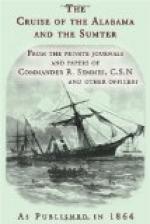The vessel to which Captain Semmes was now appointed had been built expressly for the Confederate navy, by Messrs. Laird and Sons, of Birkenhead. She was a small fast screw steam-sloop, of 1040 tons register, not iron-clad, as was at one time erroneously supposed, but built entirely of wood, and of a scantling and general construction, in which strength had been less consulted than speed. Her length over all was about 220 feet, length of keel, 210 feet; breadth of beam, 32 feet, and 18 feet from deck to keel. She carried two magnificent engines, on the horizontal principle, constructed by the same firm, and each of the power of 300 horses; while her coal-bunkers were calculated to accommodate about 350 tons of coal.
The Alabama, or as she should as yet be called, “No. 290,” was barque-rigged, her standing gear being formed throughout of wire rope; thus combining strength with lightness to the utmost possible extent. Her ordinary suit of sails consisted of the usual square sails in the foremast, fore topmast staysail and jib, large fore and main topsails, maintop sail, topgallant sail and royal, and on the mizen-mast spanker and gaff topsail. Occasionally, this rig would be varied, as was the case in entering Cherbourg, just before the close of her eventful career, when a crossjack yard was got up across the mizen-mast, with mizen topsail and topgallant yards to match; and the Alabama assumed for a time the appearance of a full-rigged ship. This, however, was only a temporary ruse, and her ordinary cruising sails were similar to those commonly in use with vessels of her class.
A little forward of the mizen-mast was placed the steering apparatus, a large double wheel, inscribed with the significant words: Aide toi et Dieu t’aidera; a motto which, in the case of the Alabama, has been better acted up to than such legends usually are. Just before the funnel, and near the centre of the vessel, was the bridge, at either side of which hung the two principal boats, cutter and launch; a gig, and whale-boat, being suspended from the davits on either side of the quarter-deck, and a small dingy over the stern. On the main deck she was pierced for twelve guns, with two heavy pivot guns amidships. Her lines were beautifully fine, with sharp flaring bows, billet head, and elliptic stern. The cabin accommodation was perhaps somewhat scanty, but this, in so small a vessel, built altogether for speed, not comfort, was scarcely to be avoided. The semicircular stern-cabin was, of course, appropriated to the captain, with a small state-room opening out from it in the starboard side. Forward of this came the companion ladder, and forward of this again the wardroom, or senior officers’ mess, with small cabins on either side for the lieutenants, surgeon, and other officers. Passing through the wardroom, the visitor entered the gunroom, or “steerage,” allotted on the starboard side to the midshipmen, and on the port to the engineers. Next came the engine-room,




